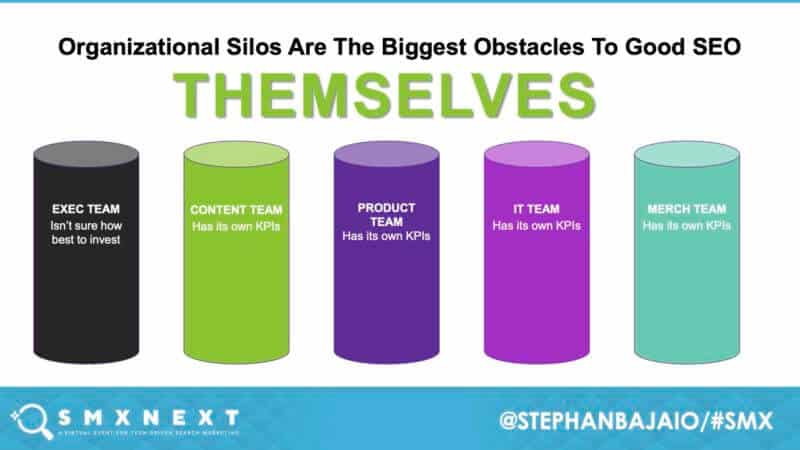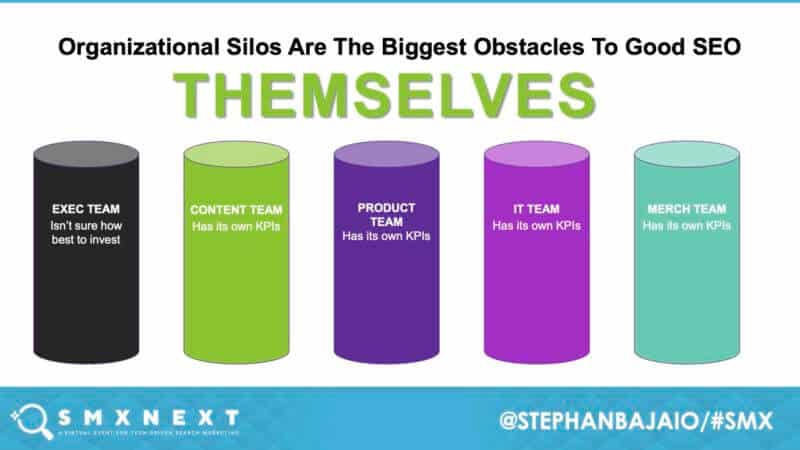SEO teams are often tasked with improving the organic visibility of an entire organization, yet any given member of that organization can make changes to the site that undo the work of their SEO colleagues. Conversely, when silos are broken down and SEO data and education are provided to every team, businesses stand to increase efficiency across the board.
“SEO done alone gets lonely results”
“You need to actually be engaging other stakeholders within the company who don’t necessarily always have the same KPIs as you,” said Conductor co-founder Stephan Bajaio in a talk during SMX Next last week. The most common reason organizations don’t succeed with SEO is because of these siloed systems in which each team is focused only on their own performance metrics, he said
Bajaio said there are benefits to having SEO managed in-house. “The value of having an in-house SEO team is that they can react faster and [take] action much quicker because they know who to go to very quickly,” he said, adding that, while third-parties can still be useful partners, they can slow down the process in this regard.
Members of other teams may make changes that inadvertently affect your site’s visibility. In-house SEO teams are positioned to prevent this by educating their colleagues on how a little awareness and effort may substantially improve your organization’s overall optimization, says SMX speaker and in-house SEO advisor for Search Engine Land Jessica Bowman.
“SEO done alone gets lonely results,” Bajaio said. Brands should approach SEO with a collaborative mindset that bridges all their teams. Doing so will not only increase the efficiency of your SEO efforts, but also provide other teams with more insights that can help them reach their own KPIs.
Build a culture of SEO by contextualizing it for other teams

Attempts to teach other team members about SEO don’t always stick because they may come off as a one-sided proposition. “If it looks like it’s self-serving . . . [then] you might be wasting time,” Bajaio said, adding, “What you really need to be doing is showing them, in their own context, how the things you’re providing the content team [for example] are going to make their content show up more, which is a KPI for them.”
This approach, which Bajaio referred to as “the internal marketing of SEO,” is more likely to resonate with other colleagues because it empowers them with data and appeals to their respective priorities. Teaching the product team, for example, to use naming conventions based on keyword data can increase the number of units sold. Similarly, sharing the search terms that lead customers to your site can enable customer service teams to work with you on adding FAQ schema, which may decrease the number of calls they’re fielding.
Evangelizing what SEO can do for other teams, using language and outcomes that they can understand, is how organizations can move towards internalizing SEO as part of their company’s culture rather than a tactic employed by a single team. “When we only contextualize it by SEO and SEO alone, we make it about us and not about them,” Bajaio said.
Use a platform that benefits all your teams
While an SEO-specific tool may aid an individual team’s work, an enterprise platform that can connect the dots between technology, data and teams can increase your organization’s efficiency across the board, Bajaio said.
Giving all your teams access to the insights SEO can yield enables them to incorporate that data into their own projects and may help foster understanding between teams. “Great SEO technology should be able to break down those silos for you and be a common place by which you can have a discussion using data and actually come together as opposed to siloing information,” he said.
Additionally, an efficient enterprise platform can help merge data sets, reducing time spent cobbling together point solutions so that team members can accomplish more of the real work. To increase adoption, Bajaio also recommends that your enterprise platform integrate with the project management tools that your teams are already using; this will bring more of your staff into the fold by supporting their existing workflow instead of introducing a new one.
Register for SMX Next for free to watch Bajaio’s full session on-demand. Here are some additional resources that can help you break down silos and make SEO a cornerstone of your company’s culture:
- SEOs and developers: Why they’re better together [Video]
- How to align SEO and sales teams so everyone benefits
- Bridging SEO and web development: How to get developers on your side
- 5 ways SEO and PR should be working together
More from SMX Next
The post How in-house SEO teams and enterprise tech can boost organizational efficiency appeared first on Search Engine Land.
Source: IAB

